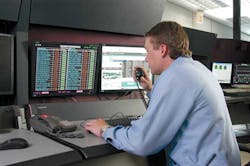Increasing Chemical Plant Security
This reduces risk, enhancing not only security, but safety,” Bill Lessig, plant manager of the Honeywell Specialty Materials plant, in Geismar, La., told an assembly of process control, chemical industry and security industry editors at the facility on March 9. The plant was constructed in 1967 along the Mississippi River. Honeywell (www.honeywell.com) produces several chemical products at the site, including hydrofluoric acid, fluorocarbon refrigerants and Alcon Resin. In early 2004, the U.S. Department of Homeland Security (DHS) advised that refineries and chemical plants were, and continue to be, potential terrorism targets. The new reality of the post-9/11 world has given momentum to industry and government initiatives aimed at enhancing the security of industrial facilities in ways that meet non-traditional threat scenarios for physical plant security, as well cyber security. "Before 9/11, security meant that I was concerned about keeping valuable tools from walking out of the plant. Now my security concerns have shifted to thinking about threats from external sources to assure business continuity, to minimize impacts in the event of an attack and to make sure the surrounding community is safe" said Lessig.
Further impetus for change came from the government. Because of its location on the Mississippi River-a key waterway-with a dock for ocean-going vessels, the Geismar plant had to develop a plan in compliance with U.S. Coast Guard regulations. Once involved with the Coast Guard, Honeywell discovered an opportunity to apply for a DHS grant that could help with the cost of adding new security upgrades. The plant implemented a layered security approach- physical security (access control/perimeter protection), electronic (video surveillance/intrusion detection) and cyber security. Because Honeywell's building and process control systems share the same distributed server architecture, the company was able to tightly integrate physical and cyber security with process control. The implementation includes a combination
of a real-time database that uses radio frequency identification (RFID)-based card readers to track the location of each employee, contractor and visitor.New visitors have photo IDs created on the spot.
When a facility has tight security and limits access to particular areas only to people with appropriate skill levels, then liability risks are decreased. Integrated systems detect incidents earlier, so abnormal situation response time is improved. And because the secuirty system has the same look and feel as the control system, engineering and training costs are reduced.
Gary Mintchell
THE PLANT HAS IMPLEMENTED WHAT IT HAS CALLED A HOLISTIC APPROACH TO THE NEEDS OF BOTH SECURITY AND PROCESS OPERATIONS. THE SECURITY PART OF THE SYSTEM INCLUDES THESE FACTORS: Identify and control who enters and exits the facility Track movements of building occupants and assets Control access to restricted areas Track and locate equipment, products and other resources Track the location of personnel on site in the event of an incident Integrate control and security systems for greater speed and efficiency Protect process automation networks and systems from cyber threats Integrate vital waterway and dock monitoring through a radar system Respond proactively to alarms and events Share security and control system data to generate cost savings.

